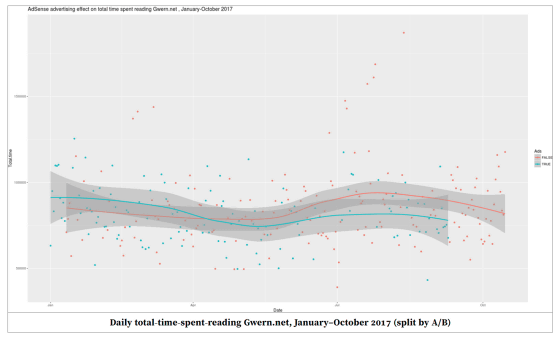How will traffic be affected if I remove banner ads from my website? The result of experimenting with A / B test is this

Many web services and apps that are provided free of charge earn revenue by displaying
Banner Ads Considered Harmful Gwern.net
https://www.gwern.net/Ads
◆Relationship between advertising and user experience
In the first place, Mr. Branwen said that he could hardly find any literature on 'How will traffic be affected by turning off advertisements?' Major advertising companies such as Google should have such data, but Google, which earns income from advertising, does not benefit from showing the 'profit of removing ads', so the information is not disclosed. .
One of the documents found by Mr. Branwen is by Google. In the study, Google said, ``It is obvious and easy to implement advertising based on short-term revenue, but it is harmful in the long run if the user experience is negatively affected.'' (PDF file) An experiment was conducted, and as a result, 'When the advertisement was reduced by 50% in mobile search, the user experience was dramatically improved.' It is not clear how much the user's activity has increased specifically, but it seems that it was shown by its own index that 'the withdrawal decreased, the activity increased, and the advertisement became visible.' is.
What happens when web services and websites reduce advertising?

Although the number is small, several websites and web services have published experimental results to measure the harm of advertising and reviews of correlation analysis. The document discovered by Mr. Branwen (left) and the place where the test was performed (right) are as follows.
01:
02: Mozilla / (PDF file) The Effect of Ad Blocking on User Engagement with the Web
03: LinkedIn / Measuring Long-term Impact of Ads on LinkedIn Feed
04: Experimental website / (PDF file) THE EFFECTS OF ONLINE ADVERTISING
05: Google / (PDF file) Focusing on the Long-term: It's Good for Users and Business
06: PageFair / (PDF file) WILL AD BLOCKING BREAK THE INTERNET?
07: Anonymous news media / Do Ads Harm News Consumption?
08: New York Times / (PDF file) Digital Paywall Design: Implications for Content Demand and Subscriptions
When these documents were analyzed, the results of the above survey were consistent that inserting advertisements would lead to a decrease in users, despite the different categories. For example, a study by streaming service Pandra showed that adding one ad per hour reduced average viewing time by 2.075%. This experiment was conducted for 21 months, but if 3.622 ads were displayed per hour, it would be calculated that there was a user loss of 7.5% after 21 months. In addition, Mozilla and LinkedIn also reportedly saw user losses due to advertising.
◆What is the result of the actual A/B test?

In order to improve the performance of the website, A / B tests are often performed to display different design and advertisement conditions for each page or for each user. However, from the viewpoint of website operation, it is pointed out that such an A / B test is ``meaningless because it only measures the performance of each page and does not measure the performance of the entire website.'' To do.
Therefore, Mr. Branwen goes beyond the framework of individual pages, measures the traffic of the entire website with Google Analytics, and ``randomly determines whether to load the advertisement in JavaScript local to the client every two days''. , made longitudinal and chronological measurements. The test was conducted for 288 days from January to October 2017, and a total of 251,164 sessions and 380,140 page views were analyzed.
Below is a regression analysis of the results of Branwen's A / B test. The red line is the traffic of users who did not display advertisements, and the blue line is the traffic of users who displayed advertisements.

Also, you can see that the time users spend reading the website is longer with no ads over time.

From the results of the analysis, Mr. Branwen shows that displaying ads reduces traffic by 9% on average and up to 14% due to the influence of users who do not use the ad blocking function. This percentage is believed to be higher for websites with more users who do not use ad blocking features.
Of course, the above results do not apply to all websites, and Mr. Branwen also mentions that ``Gwern.net is a website centered on letters''. Gwern.net has very few image elements, so hiding ads will dramatically improve loading speed. A website with a cluttered design with many images and videos may be slow to load in the first place, or the user's aversion to banner advertisements may be small, so there is a possibility that it will not lead to a dramatic change. That's what I mean.
Related Posts:
in Note, Posted by darkhorse_log







